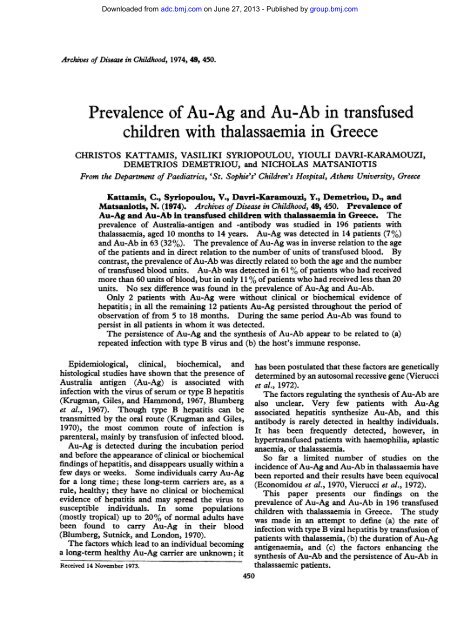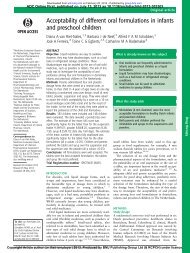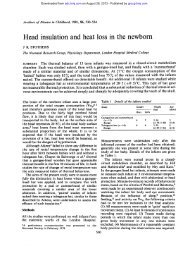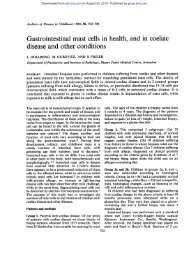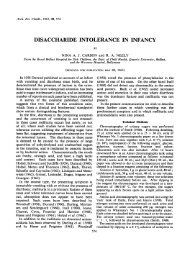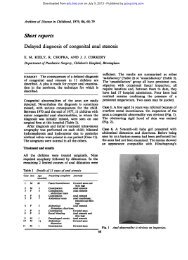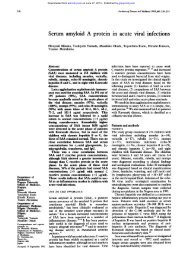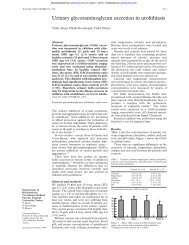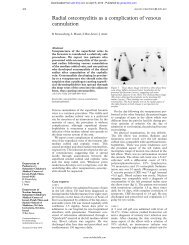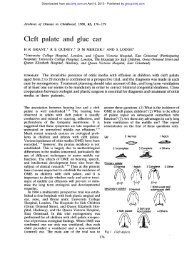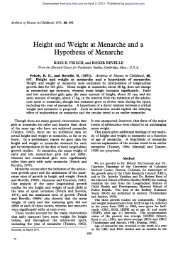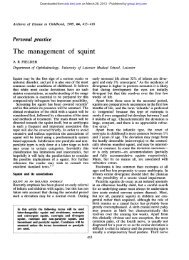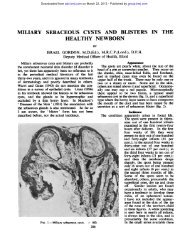Prevalence of Au-Ag and Au-Ab in transfused children with ...
Prevalence of Au-Ag and Au-Ab in transfused children with ...
Prevalence of Au-Ag and Au-Ab in transfused children with ...
Create successful ePaper yourself
Turn your PDF publications into a flip-book with our unique Google optimized e-Paper software.
Downloaded from<br />
adc.bmj.com on June 27, 2013 - Published by group.bmj.com<br />
Archives <strong>of</strong> Disease <strong>in</strong> Childhood, 1974, 49, 450.<br />
<strong>Prevalence</strong> <strong>of</strong> <strong>Au</strong>-<strong>Ag</strong> <strong>and</strong> <strong>Au</strong>-<strong>Ab</strong> <strong>in</strong> <strong>transfused</strong><br />
<strong>children</strong> <strong>with</strong> thalassaemia <strong>in</strong> Greece<br />
CHRISTOS KATTAMIS, VASILIKI SYRIOPOULOU, YIOULI DAVRI-KARAMOUZI,<br />
DEMETRIOS DEMETRIOU, <strong>and</strong> NICHOLAS MATSANIOTIS<br />
From the Department <strong>of</strong> Paediatrics, 'St. Sophie's' Children's Hospital, Athens University, Greece<br />
Kattamis, C., Syriopoulou, V., Davri-Karamouzi, Y., Demetriou, D., <strong>and</strong><br />
Matsaniotis, N. (1974). Archives <strong>of</strong> Disease <strong>in</strong> Childhood, 49, 450. <strong>Prevalence</strong> <strong>of</strong><br />
<strong>Au</strong>-<strong>Ag</strong> <strong>and</strong> <strong>Au</strong>-<strong>Ab</strong> <strong>in</strong> <strong>transfused</strong> <strong>children</strong> <strong>with</strong> thalassaemia <strong>in</strong> Greece. The<br />
prevalence <strong>of</strong> <strong>Au</strong>stralia-antigen <strong>and</strong> -antibody was studied <strong>in</strong> 196 patients <strong>with</strong><br />
thalassaemia, aged 10 months to 14 years. <strong>Au</strong>-<strong>Ag</strong> was detected <strong>in</strong> 14 patients (7%)<br />
<strong>and</strong> <strong>Au</strong>-<strong>Ab</strong> <strong>in</strong> 63 (32 %). The prevalence <strong>of</strong> <strong>Au</strong>-<strong>Ag</strong> was <strong>in</strong> <strong>in</strong>verse relation to the age<br />
<strong>of</strong> the patients <strong>and</strong> <strong>in</strong> direct relation to the number <strong>of</strong> units <strong>of</strong> <strong>transfused</strong> blood. By<br />
contrast, the prevalence <strong>of</strong> <strong>Au</strong>-<strong>Ab</strong> was directly related to both the age <strong>and</strong> the number<br />
<strong>of</strong> <strong>transfused</strong> blood units. <strong>Au</strong>-<strong>Ab</strong> was detected <strong>in</strong> 61 % <strong>of</strong> patients who had received<br />
more than 60 units <strong>of</strong> blood, but <strong>in</strong> only 11% <strong>of</strong> patients who had received less than 20<br />
units. No sex difference was found <strong>in</strong> the prevalence <strong>of</strong> <strong>Au</strong>-<strong>Ag</strong> <strong>and</strong> <strong>Au</strong>-<strong>Ab</strong>.<br />
Only 2 patients <strong>with</strong> <strong>Au</strong>-<strong>Ag</strong> were <strong>with</strong>out cl<strong>in</strong>ical or biochemical evidence <strong>of</strong><br />
hepatitis; <strong>in</strong> all the rema<strong>in</strong><strong>in</strong>g 12 patients <strong>Au</strong>-<strong>Ag</strong> persisted throughout the period <strong>of</strong><br />
observation <strong>of</strong> from 5 to 18 months. Dur<strong>in</strong>g the same period <strong>Au</strong>-<strong>Ab</strong> was found to<br />
persist <strong>in</strong> all patients <strong>in</strong> whom it was detected.<br />
The persistence <strong>of</strong> <strong>Au</strong>-<strong>Ag</strong> <strong>and</strong> the synthesis <strong>of</strong> <strong>Au</strong>-<strong>Ab</strong> appear to be related to (a)<br />
repeated <strong>in</strong>fection <strong>with</strong> type B virus <strong>and</strong> (b) the host's immune response.<br />
Epidemiological, cl<strong>in</strong>ical, biochemical, <strong>and</strong> has been postulated that these factors are genetically<br />
histological studies have shown that the presence <strong>of</strong> determ<strong>in</strong>ed by an autosomal recessive gene (Vierucci<br />
<strong>Au</strong>stralia antigen (<strong>Au</strong>-<strong>Ag</strong>) is associated <strong>with</strong> et al., 1972).<br />
<strong>in</strong>fection <strong>with</strong> the virus <strong>of</strong> serum or type B hepatitis The factors regulat<strong>in</strong>g the synthesis <strong>of</strong> <strong>Au</strong>-<strong>Ab</strong> are<br />
(Krugman, Giles, <strong>and</strong> Hammond, 1967, Blumberg also unclear. Very few patients <strong>with</strong> <strong>Au</strong>-<strong>Ag</strong><br />
et al., 1967). Though type B hepatitis can be associated hepatitis synthesize <strong>Au</strong>-<strong>Ab</strong>, <strong>and</strong> this<br />
transmitted by the oral route (Krugman <strong>and</strong> Giles, antibody is rarely detected <strong>in</strong> healthy <strong>in</strong>dividuals.<br />
1970), the most common route <strong>of</strong> <strong>in</strong>fection is It has been frequently detected, however, <strong>in</strong><br />
parenteral, ma<strong>in</strong>ly by transfusion <strong>of</strong> <strong>in</strong>fected blood. hyper<strong>transfused</strong> patients <strong>with</strong> haemophilia, aplastic<br />
<strong>Au</strong>-<strong>Ag</strong> is detected dur<strong>in</strong>g the <strong>in</strong>cubation period anaemia, or thalassaemia.<br />
<strong>and</strong> before the appearance <strong>of</strong> cl<strong>in</strong>ical or biochemical So far a limited number <strong>of</strong> studies on the<br />
f<strong>in</strong>d<strong>in</strong>gs <strong>of</strong> hepatitis, <strong>and</strong> disappears usually <strong>with</strong><strong>in</strong> a <strong>in</strong>cidence <strong>of</strong> <strong>Au</strong>-<strong>Ag</strong> <strong>and</strong> <strong>Au</strong>-<strong>Ab</strong> <strong>in</strong> thalassaemia have<br />
few days or weeks. Some <strong>in</strong>dividuals carry <strong>Au</strong>-<strong>Ag</strong> been reported <strong>and</strong> their results have been equivocal<br />
for a long time; these long-term carriers are, as a (Economidou et al., 1970, Vierucci et al., 1972).<br />
rule, healthy; they have no cl<strong>in</strong>ical or biochemical This paper presents our f<strong>in</strong>d<strong>in</strong>gs on the<br />
evidence <strong>of</strong> hepatitis <strong>and</strong> may spread the virus to prevalence <strong>of</strong> <strong>Au</strong>-<strong>Ag</strong> <strong>and</strong> <strong>Au</strong>-<strong>Ab</strong> <strong>in</strong> 196 <strong>transfused</strong><br />
susceptible <strong>in</strong>dividuals. In some populations <strong>children</strong> <strong>with</strong> thalassaemia <strong>in</strong> Greece. The study<br />
(mostly tropical) up to 20% <strong>of</strong> normal adults have was made <strong>in</strong> an attempt to def<strong>in</strong>e (a) the rate <strong>of</strong><br />
been found to carry <strong>Au</strong>-<strong>Ag</strong> <strong>in</strong> their blood <strong>in</strong>fection <strong>with</strong> type B viral hepatitis by transfusion <strong>of</strong><br />
(Blumberg, Sutnick, <strong>and</strong> London, 1970).<br />
patients <strong>with</strong> thalassemia, (b) the duration <strong>of</strong> <strong>Au</strong>-<strong>Ag</strong><br />
The factors which lead to an <strong>in</strong>dividual becom<strong>in</strong>g antigenaemia, <strong>and</strong> (c) the factors enhanc<strong>in</strong>g the<br />
a long-term healthy <strong>Au</strong>-<strong>Ag</strong> carrier are unknown; it synthesis <strong>of</strong> <strong>Au</strong>-<strong>Ab</strong> <strong>and</strong> the persistence <strong>of</strong> <strong>Au</strong>-<strong>Ab</strong> <strong>in</strong><br />
Received 14 November 1973.<br />
thalassaemic patients.<br />
450
Downloaded from<br />
adc.bmj.com on June 27, 2013 - Published by group.bmj.com<br />
<strong>Prevalence</strong> <strong>of</strong> <strong>Au</strong>-<strong>Ag</strong> <strong>and</strong> <strong>Au</strong>-<strong>Ab</strong> <strong>in</strong> <strong>transfused</strong> <strong>children</strong> <strong>with</strong> thalassaemia <strong>in</strong> Greece<br />
Material <strong>and</strong> methods<br />
196 patients (94 males <strong>and</strong> 102 females) <strong>with</strong><br />
homozygous ,-thalassaemia, aged 10 months to 14 years,<br />
attend<strong>in</strong>g the Haemolytic Anaemia Unit <strong>of</strong> the Paediatric<br />
Department <strong>of</strong> Athens University, were studied. They<br />
were on different transfusion regimens <strong>in</strong> regard to<br />
pretransfusion Hb levels. However, most were on a<br />
frequent transfusion regimen, i.e. they were <strong>transfused</strong><br />
when the Hb level fell to 8 g/100 ml.<br />
More than 600 serum samples collected from these<br />
patients before transfusion on several occasions were<br />
tested for <strong>Au</strong>-<strong>Ag</strong> <strong>and</strong> <strong>Au</strong>-<strong>Ab</strong> by immunoelectroosmophoresis,<br />
us<strong>in</strong>g 1% agarose <strong>in</strong> barbitone buffer, pH<br />
8-2, <strong>and</strong> ionic strength 0 05 ,um. The antibody used<br />
was obta<strong>in</strong>ed from pooled sera from patients <strong>with</strong><br />
homozygous P-thalassaemia who were frequently<br />
<strong>transfused</strong>.<br />
Results<br />
<strong>Prevalence</strong> <strong>of</strong> <strong>Au</strong>-<strong>Ag</strong> <strong>and</strong> <strong>Au</strong>-<strong>Ab</strong>. The<br />
results on the prevalence <strong>Au</strong>-<strong>Ag</strong> <strong>and</strong> <strong>Au</strong>-<strong>Ab</strong> among<br />
196 <strong>children</strong> studied are summarized <strong>in</strong> Table I.<br />
TABLE I<br />
<strong>Prevalence</strong> <strong>of</strong> <strong>Au</strong>-<strong>Ag</strong> <strong>and</strong> <strong>Au</strong>-<strong>Ab</strong> <strong>in</strong> 196 <strong>children</strong> <strong>with</strong><br />
,B-thalassaemia<br />
Detection <strong>of</strong> Detection <strong>of</strong><br />
<strong>Au</strong>-<strong>Ag</strong> <strong>Au</strong>-<strong>Ab</strong><br />
Patients No. <strong>of</strong><br />
cases No. <strong>of</strong> % No. <strong>of</strong> %<br />
cases cases<br />
Males 94 7 7 30 32<br />
Females 102 7 7 33 32<br />
Total 196 14 7 63 32<br />
<strong>Au</strong>-<strong>Ag</strong> was detected <strong>in</strong> 14 (7%) <strong>and</strong> <strong>Au</strong>-<strong>Ab</strong> <strong>in</strong> 63<br />
(32%) <strong>children</strong>. No difference <strong>in</strong> the prevalence <strong>of</strong><br />
either <strong>Au</strong>-<strong>Ag</strong> or <strong>Au</strong>-<strong>Ab</strong> was found between boys <strong>and</strong><br />
14 M <strong>Au</strong>-<strong>Ag</strong>(+)<br />
13 M <strong>Au</strong>-<strong>Ab</strong>(+)<br />
12 ED <strong>Au</strong>-<strong>Ag</strong>(-)<br />
II<br />
9<br />
o8<br />
,,7<br />
06<br />
U6<br />
2<br />
1 2 3 4 S 6 7 8 9 I1 12 13 14 15 16 17 18<br />
Time <strong>in</strong> months<br />
FIG.-Persistence <strong>of</strong> <strong>Au</strong>-antigenaemia <strong>in</strong> 14 patients <strong>with</strong><br />
thalassaemia.<br />
girls. None <strong>of</strong> these patients carried both <strong>Au</strong>-<strong>Ag</strong><br />
<strong>and</strong> <strong>Au</strong>-<strong>Ab</strong>.<br />
The persistence <strong>of</strong> <strong>Au</strong>-<strong>Ag</strong> <strong>in</strong> the 14 patients is<br />
illustrated <strong>in</strong> the Fig. Only 2 <strong>of</strong> these patients<br />
(Cases 1 <strong>and</strong> 14) had cl<strong>in</strong>ical <strong>and</strong> biochemical<br />
evidence <strong>of</strong> hepatitis <strong>and</strong> <strong>in</strong> both <strong>Au</strong>-<strong>Ag</strong> disappeared<br />
<strong>with</strong><strong>in</strong> about 1 month. In Case 1 antibody was<br />
detected after 2 months.<br />
The rema<strong>in</strong><strong>in</strong>g 12 patients had no cl<strong>in</strong>ical or<br />
biochemical evidence <strong>of</strong> hepatitis but <strong>Au</strong>-<strong>Ag</strong><br />
persisted throughout the observation period, which<br />
varied from 5 to 18 months.<br />
Relation <strong>of</strong> prevalence <strong>of</strong> <strong>Au</strong>-<strong>Ag</strong> <strong>and</strong> <strong>Au</strong>-<strong>Ab</strong><br />
to age <strong>and</strong> number <strong>of</strong> <strong>transfused</strong> blood units.<br />
This is shown <strong>in</strong> Table II. It is evident that the<br />
TABLE II<br />
Relation <strong>of</strong> prevalence <strong>of</strong> <strong>Au</strong>-<strong>Ag</strong> <strong>and</strong> <strong>Au</strong>-<strong>Ab</strong> to age <strong>and</strong> number <strong>of</strong> <strong>transfused</strong> blood units<br />
Statistical analysis Statistical analysis<br />
Total no. Detection <strong>of</strong> <strong>Au</strong>-<strong>Ag</strong> by X2 Detection <strong>of</strong> <strong>Au</strong>-<strong>Ab</strong> by X2<br />
Groups <strong>of</strong> cases<br />
No. <strong>of</strong> cases 0% Groups P No. <strong>of</strong> cases % Groups p<br />
<strong>Ag</strong>e (yr)<br />
I 1-4 58 6 10 IJ:I
Downloaded from<br />
adc.bmj.com on June 27, 2013 - Published by group.bmj.com<br />
Kattamis, Syriopoulou, Davri-Karamouzi, Demetriou, <strong>and</strong> Matsaniotis<br />
452<br />
<strong>in</strong>cidence <strong>of</strong> <strong>Au</strong>-<strong>Ag</strong> decreases, whereas that <strong>of</strong><br />
<strong>Au</strong>-<strong>Ab</strong> <strong>in</strong>creases <strong>with</strong> <strong>in</strong>creas<strong>in</strong>g age.<br />
The <strong>in</strong>crease <strong>in</strong> the <strong>in</strong>cidence <strong>of</strong> <strong>Au</strong>-<strong>Ab</strong> was more<br />
impressive <strong>in</strong> the older group (9-14 years) <strong>of</strong> patients<br />
<strong>with</strong> thalassaemia; <strong>in</strong> this group the <strong>in</strong>cidence <strong>of</strong><br />
<strong>Au</strong>-<strong>Ab</strong> was much higher (55%) than <strong>in</strong> the younger<br />
age group (14%).<br />
The <strong>in</strong>cidence <strong>of</strong> <strong>Au</strong>-<strong>Ab</strong> was proportional to the<br />
amount <strong>of</strong> blood <strong>transfused</strong>, whereas the <strong>in</strong>cidence<br />
<strong>of</strong> <strong>Au</strong>-<strong>Ag</strong> appeared to be <strong>in</strong>versely proportional.<br />
Thus, the <strong>in</strong>cidence <strong>of</strong> <strong>Au</strong>-<strong>Ag</strong> was considerably<br />
higher <strong>in</strong> those patients who had received less than<br />
20 units <strong>of</strong> blood, than <strong>in</strong> those who had received 41<br />
to 60 or >60 blood units (Table II). In fact, the<br />
<strong>in</strong>cidence <strong>of</strong> <strong>Au</strong>-<strong>Ag</strong> dropped to zero <strong>in</strong> the last group<br />
(P
Downloaded from<br />
adc.bmj.com on June 27, 2013 - Published by group.bmj.com<br />
<strong>Prevalence</strong> <strong>of</strong> <strong>Au</strong>-<strong>Ag</strong> <strong>and</strong> <strong>Au</strong>-<strong>Ab</strong> <strong>in</strong> <strong>transfused</strong> <strong>children</strong> <strong>with</strong> thalassaemia <strong>in</strong> Greece 453<br />
absence <strong>of</strong> cl<strong>in</strong>ical signs <strong>in</strong> most patients <strong>of</strong> this<br />
series <strong>in</strong>fected by type B hepatitis virus. Undoubtedly,<br />
the young age <strong>of</strong> the patients was an<br />
important factor, s<strong>in</strong>ce it is well known that hepatitis<br />
runs a very mild course <strong>and</strong> frequently is anicteric <strong>in</strong><br />
<strong>children</strong>. Furthermore, <strong>in</strong> our experience there is<br />
no demonstrable difference <strong>in</strong> the cl<strong>in</strong>ical course <strong>and</strong><br />
prognosis <strong>of</strong> hepatitis associated <strong>with</strong> <strong>Au</strong>-<strong>Ag</strong> <strong>and</strong><br />
that not associated <strong>with</strong> <strong>Au</strong>-<strong>Ag</strong>. Another factor<br />
which could modify the cl<strong>in</strong>ical course <strong>of</strong> hepatitis <strong>in</strong><br />
our patients is the fact that they were <strong>transfused</strong> <strong>with</strong><br />
whole blood. Though the evidence on the<br />
preventive value <strong>of</strong> y-globul<strong>in</strong> <strong>in</strong> type B hepatitis is<br />
still conflict<strong>in</strong>g, the possibility <strong>of</strong> a favourable effect<br />
<strong>of</strong> regular transfusion <strong>of</strong> considerable amounts <strong>of</strong><br />
plasma cannot be excluded <strong>in</strong> our patients.<br />
The long-term prognosis <strong>of</strong> these patients, <strong>in</strong><br />
whom the type B hepatitis apparently ran a mild<br />
cl<strong>in</strong>ical course <strong>with</strong> no serious complications dur<strong>in</strong>g<br />
the acute phase, cannot be predicted <strong>with</strong> certa<strong>in</strong>ty.<br />
Vierucci et al. (1972) postulated that the persistence<br />
<strong>of</strong> <strong>Au</strong>-<strong>Ag</strong> <strong>in</strong> thalassaemic <strong>children</strong> contributes to<br />
early mortality. We were not able to confirm this<br />
assumption for we had no deaths dur<strong>in</strong>g the<br />
observation period <strong>in</strong> our series, which consisted<br />
ma<strong>in</strong>ly <strong>of</strong> <strong>children</strong> below 12 years <strong>of</strong> age; it is our<br />
impression that some older patients developed<br />
cl<strong>in</strong>ical <strong>and</strong> biochemical signs <strong>of</strong> cirrhosis earlier<br />
than would have been expected from the number <strong>of</strong><br />
transfusions <strong>and</strong> the degree <strong>of</strong> haemosiderosis, <strong>and</strong><br />
that cirrhosis was associated <strong>with</strong> previous <strong>in</strong>fection<br />
<strong>with</strong> type B viral hepatitis, s<strong>in</strong>ce most <strong>of</strong> these<br />
patients had <strong>Au</strong>-<strong>Ab</strong> <strong>in</strong> their serum.<br />
We were unable to confirm either the higher<br />
<strong>in</strong>cidence <strong>of</strong> <strong>Au</strong>-<strong>Ag</strong> <strong>in</strong> males or the higher frequency<br />
<strong>of</strong> <strong>Au</strong>-<strong>Ab</strong> <strong>in</strong> females <strong>in</strong> published reports. In our<br />
series there were no sex differences <strong>in</strong> the <strong>in</strong>cidence<br />
<strong>of</strong> <strong>Au</strong>-<strong>Ag</strong> <strong>and</strong> <strong>Au</strong>-<strong>Ab</strong>.<br />
The last po<strong>in</strong>t to discuss is the factors enhanc<strong>in</strong>g<br />
<strong>Au</strong>-<strong>Ab</strong> synthesis. <strong>Au</strong>-<strong>Ab</strong> is detected <strong>in</strong> healthy<br />
<strong>in</strong>dividuals rarely <strong>and</strong> only exceptionally <strong>in</strong> patients<br />
<strong>with</strong> type B hepatitis. Undoubtedly the regulation<br />
<strong>of</strong> antibody synthesis is multifactorial, but the<br />
function <strong>of</strong> immune mechanism <strong>of</strong> the host <strong>and</strong> the<br />
way by which it is stimulated by the <strong>in</strong>fectious agent<br />
are <strong>of</strong> primary importance. Cl<strong>in</strong>ical <strong>and</strong> experi-<br />
mental studies have shown that <strong>Au</strong>-<strong>Ab</strong> is usually<br />
produced after repeated <strong>in</strong>fection <strong>with</strong> type B<br />
hepatitis. This expla<strong>in</strong>s the high <strong>in</strong>cidence (61%)<br />
<strong>of</strong> <strong>Au</strong>-<strong>Ab</strong> <strong>in</strong> our patients who had received more<br />
than 60 blood units <strong>and</strong> its very low <strong>in</strong>cidence (13%)<br />
<strong>in</strong> those who had received less than 20 blood units.<br />
In view <strong>of</strong> the high <strong>in</strong>cidence <strong>of</strong> <strong>Au</strong>-<strong>Ag</strong> among blood<br />
donors <strong>in</strong> Greece, it may be assumed that hyper<strong>transfused</strong><br />
patients <strong>with</strong> thalassaemia have<br />
repeatedly received <strong>in</strong>fected blood. We are led to<br />
conclude that repeated stimulation <strong>of</strong> the host's<br />
immune system by <strong>Au</strong>-<strong>Ag</strong> appears to be one <strong>of</strong> the<br />
factors regulat<strong>in</strong>g the production <strong>of</strong> <strong>Au</strong>-antibody.<br />
We are grateful to the medical <strong>and</strong> nurs<strong>in</strong>g staffs <strong>of</strong> the<br />
Department <strong>of</strong> Paediatrics for help <strong>in</strong> the treatment <strong>of</strong><br />
thalassaemic patients, <strong>and</strong> to Dr. Cleopatra Oeconomou-<br />
Mavrou for editorial work.<br />
REFIENCES<br />
Blumberg, P. S., Gerstley, B. J. S., Hungerford, D. A., London,<br />
W. T., <strong>and</strong> Sutnick, A. I. (1967). A serum antigen (<strong>Au</strong>stralia<br />
antigen) <strong>in</strong> Down's syndrome, leukemia, <strong>and</strong> hepatitis. Annals<br />
<strong>of</strong> Internal Medic<strong>in</strong>e, 66, 924.<br />
Blumberg, B. S., Sutnick, A. I., <strong>and</strong> London, W. T. (1970).<br />
<strong>Au</strong>stralia antigen as a hepatitis virus: variation <strong>in</strong> host response.<br />
American Journal <strong>of</strong> Medic<strong>in</strong>e, 48, 1.<br />
Cossart, Y. E. (1972). What determ<strong>in</strong>es the <strong>in</strong>cidence <strong>of</strong> serum<br />
hepatitis after blood transfusion? American3Journal <strong>of</strong> Diseases<br />
<strong>of</strong> Children, 123, 354.<br />
Economidou, J., Konstantoulakis, M., Avgustaki, G., Taylor, P. E.,<br />
Zuckerman, A. J., Ba<strong>in</strong>es, P. M., <strong>and</strong> Bryceson, M. A. (1970).<br />
The <strong>in</strong>cidence <strong>of</strong> hepatitis-associated antigen <strong>and</strong> antibody <strong>in</strong><br />
patients <strong>with</strong> thalassemia <strong>in</strong> Greece. (<strong>Ab</strong>st.) XIII Congress <strong>of</strong><br />
Haematology, Munich, <strong>Au</strong>gust 1970, p. 402.<br />
Hadziyannis, S. J., Merikas, G. E., Afroudakis, A. P., Panetsos, S.,<br />
<strong>and</strong> Moussouros, A. (1970). Observations on <strong>Au</strong>stralia (<strong>Au</strong>)<br />
antigen <strong>in</strong> Greece. Iatriki, 18, 221.<br />
Krugman, S., <strong>and</strong> Giles, J. P. (1970). Viral hepatitis; new light on<br />
an old disease. Journal <strong>of</strong> the American Medical Association,<br />
212, 1019.<br />
Krugman, S., Giles, J. P., <strong>and</strong> Hammond, J. (1967). Infectious<br />
hepatitis. Evidence for two dist<strong>in</strong>ctive cl<strong>in</strong>ical, epidemiological,<br />
<strong>and</strong> immunological types <strong>of</strong> <strong>in</strong>fection. Journal <strong>of</strong> the<br />
American Medical Association, 200, 365.<br />
London, W. T., Sutnick, A. I., <strong>and</strong> Blumberg, B. S. (1969).<br />
<strong>Au</strong>stralia antigen <strong>and</strong> acute viral hepatitis. Annals <strong>of</strong> Internal,<br />
Medic<strong>in</strong>e, 70, 55.<br />
Vierucci, A., London, W. T., Blumberg, B. S., Sutnick, A. I., <strong>and</strong><br />
Ragazz<strong>in</strong>i, F. (1972). <strong>Au</strong>stralia antigen <strong>and</strong> antibody <strong>in</strong><br />
<strong>transfused</strong> <strong>children</strong> <strong>with</strong> thalassaemia. Archives <strong>of</strong> Disease <strong>in</strong><br />
Childhood, 47, 760.<br />
Correspondence to Dr. C. Kattamis, Athens<br />
University Department <strong>of</strong> Paediatrics, 'St. Sophie's'<br />
Children's Hospital, Athens 608, Greece.
Downloaded from<br />
adc.bmj.com on June 27, 2013 - Published by group.bmj.com<br />
Email alert<strong>in</strong>g<br />
service<br />
Notes<br />
<strong>Prevalence</strong> <strong>of</strong> <strong>Au</strong>-<strong>Ag</strong> <strong>and</strong> <strong>Au</strong>-<strong>Ab</strong><br />
<strong>in</strong> <strong>transfused</strong> <strong>children</strong> <strong>with</strong><br />
thalassaemia <strong>in</strong> Greece<br />
Christos Kattamis, Vasiliki Syriopoulou, Yiouli<br />
Davri-Karamouzi, et al.<br />
Arch Dis Child 1974 49: 450-453<br />
doi: 10.1136/adc.49.6.450<br />
Updated <strong>in</strong>formation <strong>and</strong> services can be found at:<br />
http://adc.bmj.com/content/49/6/450<br />
These <strong>in</strong>clude:<br />
To request permissions go to:<br />
http://group.bmj.com/group/rights-licens<strong>in</strong>g/permissions<br />
To order repr<strong>in</strong>ts go to:<br />
http://journals.bmj.com/cgi/repr<strong>in</strong>tform<br />
To subscribe to BMJ go to:<br />
http://group.bmj.com/subscribe/<br />
Receive free email alerts when new articles cite this<br />
article. Sign up <strong>in</strong> the box at the top right corner <strong>of</strong><br />
the onl<strong>in</strong>e article.


